Whether you’re planning a holiday on the canals or thinking of living aboard, driving a narrowboat is a crucial skill to learn.
It can seem intimidating at first, but it’s something you can pick up within a couple of hours—and you don’t even need a licence! If you abide by the waterway code and follow our advice, you’ll be chugging along in no time.
Here you’ll find plenty of tips on driving and steering a narrowboat and where to find lessons if you want to boost your confidence.
#1 – Setting off
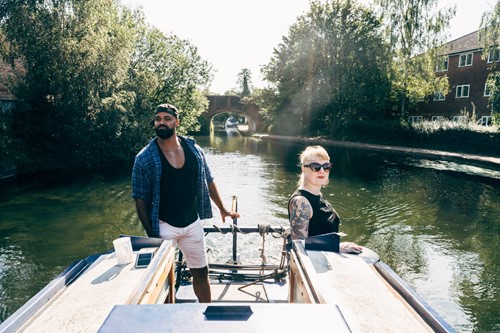
Before making a move, you should always start the engine and leave it running for 5 minutes. This allows it to warm up ahead of setting off.
You’ll also need to ensure you have a designated ‘skipper’ (a person in charge of the controls) and a crew member aboard, especially if this is your first time driving a narrowboat.
How you set off depends on the water your narrowboat is in.
In deep water, your team should:
- Remove any mooring pins from the bank (if in use)
- Untie the front rope and gently push off from the front
- Untie the back rope, and gently push off from the back as you climb aboard
The skipper will motor away from the bank as the crew member hops aboard and stows the ropes safely. This prevents them from trailing overboard and getting caught in the propeller.
It’s important to push off from the back first when in deep water, as narrowboats steer from the back. By having the front of the boat pointed towards the centre of the canal, the engine will push it in the right direction.
In shallow water, your team should:
- Push the back of the boat off first
- Use reverse gear whilst steering the boat away from the bank
- Shift into forward gear once you’ve cleared the bank, then motor away
Pushing off from the back first is the best option when in shallow water or moored in a busy area, as this allows the boat more room to get clear of the bank and gives the skipper more control.
Related: How to get your narrowboat ready for spring in 7 simple steps
#2 – Steering a narrowboat
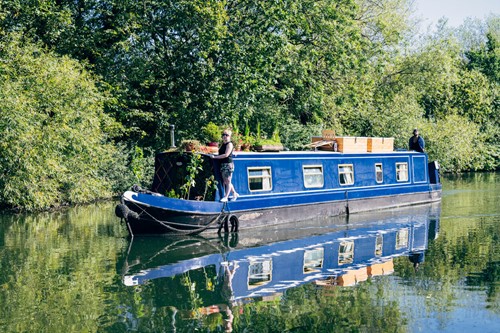
Learning how to steer a narrowboat is simple, despite the prospect of steering a 57ft vessel being quite intimidating.
To give a quick overview of how narrowboat steering works, you’ll be using a mechanism called a tiller to manoeuvre your boat. It directs the stern (back of the boat) to the direction you wish to travel in.
For the most part, you need to remember two simple rules:
- To steer to the right, you need to push the tiller left
- To steer to the left, you need to push the tiller right
It’s also important to remember that there are always a few seconds delay from the point you steer to the boat changing direction. This time increases the slower the speed you’re travelling at.
It would help if you allowed plenty of time for your steering to take effect, especially when you’re steering around an obstacle.
When lining up your narrowboat to turn a tight corner, you should ensure you line up both the front and back of the boat. If you only consider the front, the back of the boat could collide with the bank.
Strictly speaking, most narrowboats pivot around their midpoint. Keeping this in mind should help you know when to begin steering around a corner or into a narrow gap.
Related: Complete guide to the UK canal system
#3 – Slowing down and stopping

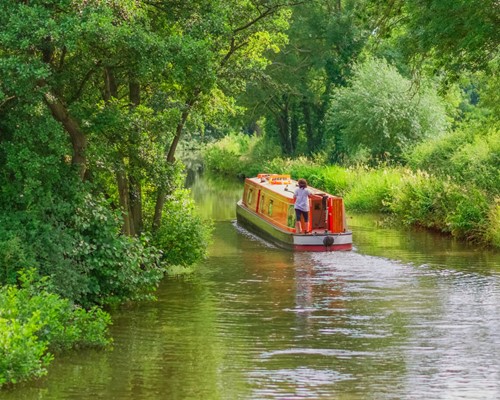
First things first, narrowboats don’t have brakes. This makes sticking to the 4mph speed limit incredibly important.
But don’t panic; there’s an incredibly simple way to slow things down and keep everyone on board safe.
To slow down when driving a narrowboat, you should:
- Ease off the engine lever, and move it into neutral
- Push the lever into reverse gear
- Remain in reverse gear to slow down
Pushing the lever into reverse will engage the fuel injection pump and increase the engine speed by spinning the propeller faster. This pulls the boat backwards and allows you to bring it to a halt.
It works pretty much the same as forward gear, but you have less control over steering when in reverse gear. You can use bursts of forward gear to gain more control.
Our biggest tip for slowing down or stopping when driving a narrowboat is to always be on the lookout for potential hazards or obstacles in your path. Give yourself plenty of time to slow the boat down by keeping an eye on the horizon.
Although you’ll only be travelling at 4mph, it’s a good idea to plan your route and anticipate any locks, bridges, or tunnels and any sharp bends.
Related: The costs of living on a narrowboat
#4 – Reversing
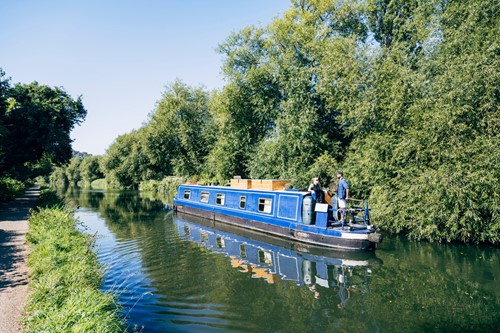
You’ll have little to no control over your direction when reversing a narrowboat since boats aren’t designed to travel this way.
However, we have some useful tips for making this process less complicated, although it naturally takes some practice.
Firstly, you should take it easy and move slowly. Whilst in forward gear, you should position the tiller at around 60 degrees against the direction you wish to travel since the boat will move the opposite way.
Once the stern has been correctly positioned, the boat will begin to drift in the right direction.
Before it reaches this point, you should switch into reverse gear to allow the boat the momentum it needs to travel backwards and line up correctly, rather than swinging towards the bank.
Lining the boat up may involve going back and forth by repeating the steps above due to the lack of control over steering a narrowboat backwards, but this is the safest way to reverse.
Related: The best narrowboat YouTube channels
#5 – Mooring
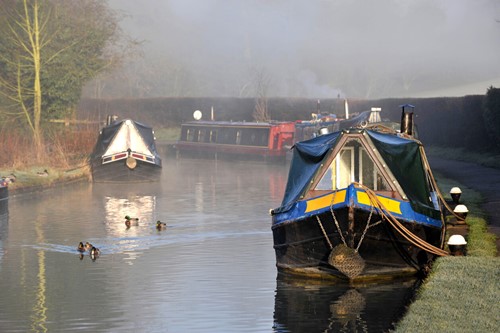
As with all narrowboat manoeuvres, you should complete the mooring process slowly. It would help if you also planned out where you wish to moor in advance and ensure everyone aboard knows their role.
For the skipper, the steps are as follows:
- Using reverse gear, stop the boat ahead of where you wish to moor
- Ensure the boat is straight and lined up correctly
- Slowly move forward, and use the tiller to guide the boat towards the bank
- Just before the bow meets the bank, use reverse gear to stop the boat
- Put the engine into neutral
At this point, a crewmember will carefully step off the boat and onto the shore with a mooring rope. They will secure the front of the boat.
The skipper will then direct the back of the boat towards the bank with the tiller correctly positioned and the engine in forward gear. Once the boat is parallel with the bank, they will stop by shifting it into reverse gear.
Either the skipper or another crewmember will then step ashore and secure the back of the boat with another mooring rope.
To see this in action, view the video below:
Where to find lessons
One of the best ways to boost your confidence when driving a narrowboat is to take a short course with a team of professionals. That way, you can feel safe knowing that you have a good feel for your narrowboat before you set off.
You don’t require any training to cruise a narrowboat on the UK canal network, but it’s a great idea if you’re inexperienced and want to avoid any mishaps.
The most recommended providers are:
- RYA (RYA Inland Waterways Helmsman Course is recommended by the Canal & River Trust)
- Canal Junction
- Narrowboat Skills Centre
Specialist narrowboat insurance from Insure4Boats
Looking to purchase your narrowboat in time for spring? We can’t say we blame you, as the weather has been perfect for exploring the canal network.
But before you set off, you need to make sure you have the right insurance.
At Insure4Boats, our specialist narrowboat insurance protects your boat against theft, accidental damage, and malicious damage. It also comes with many optional extras, including contents, frost, and personal accident cover.
We also provide £3million Public Liability cover with every policy, so you’re protected in the event of an accident on the waterways or if you cause damage to another boat.
Get an instant online quote now by clicking the button below, and ensure your new narrowboat is protected.
-
Related
Guide to living on a narrowboat (pros, cons & cost)
The UK’s most romantic narrowboat destinations
The best narrowboat accessories to have onboard
Please note the information provided on this page should not be taken as advice and has been written as a matter of opinion. For more on insurance cover and policy wording, see our homepage.


